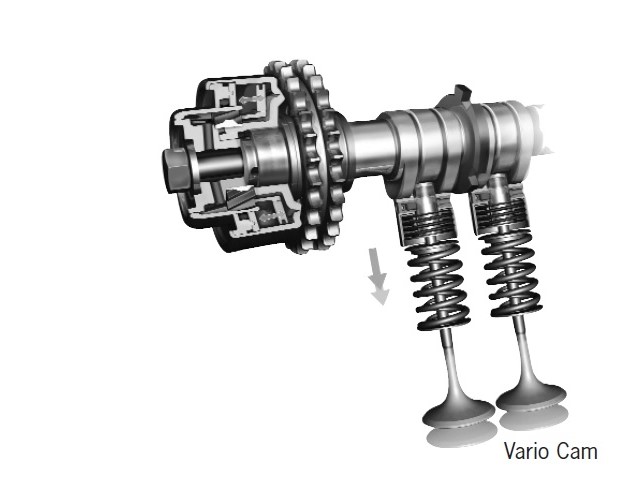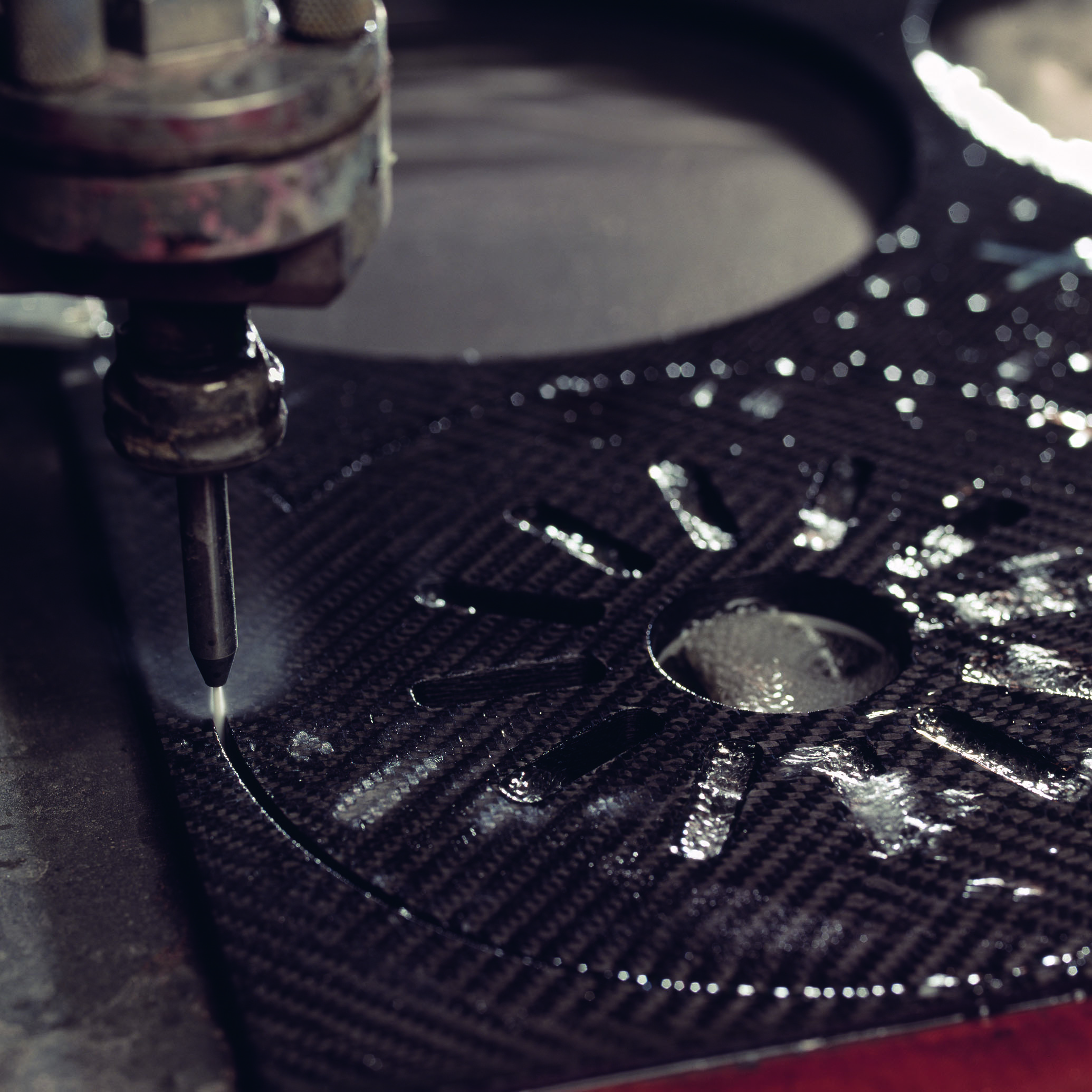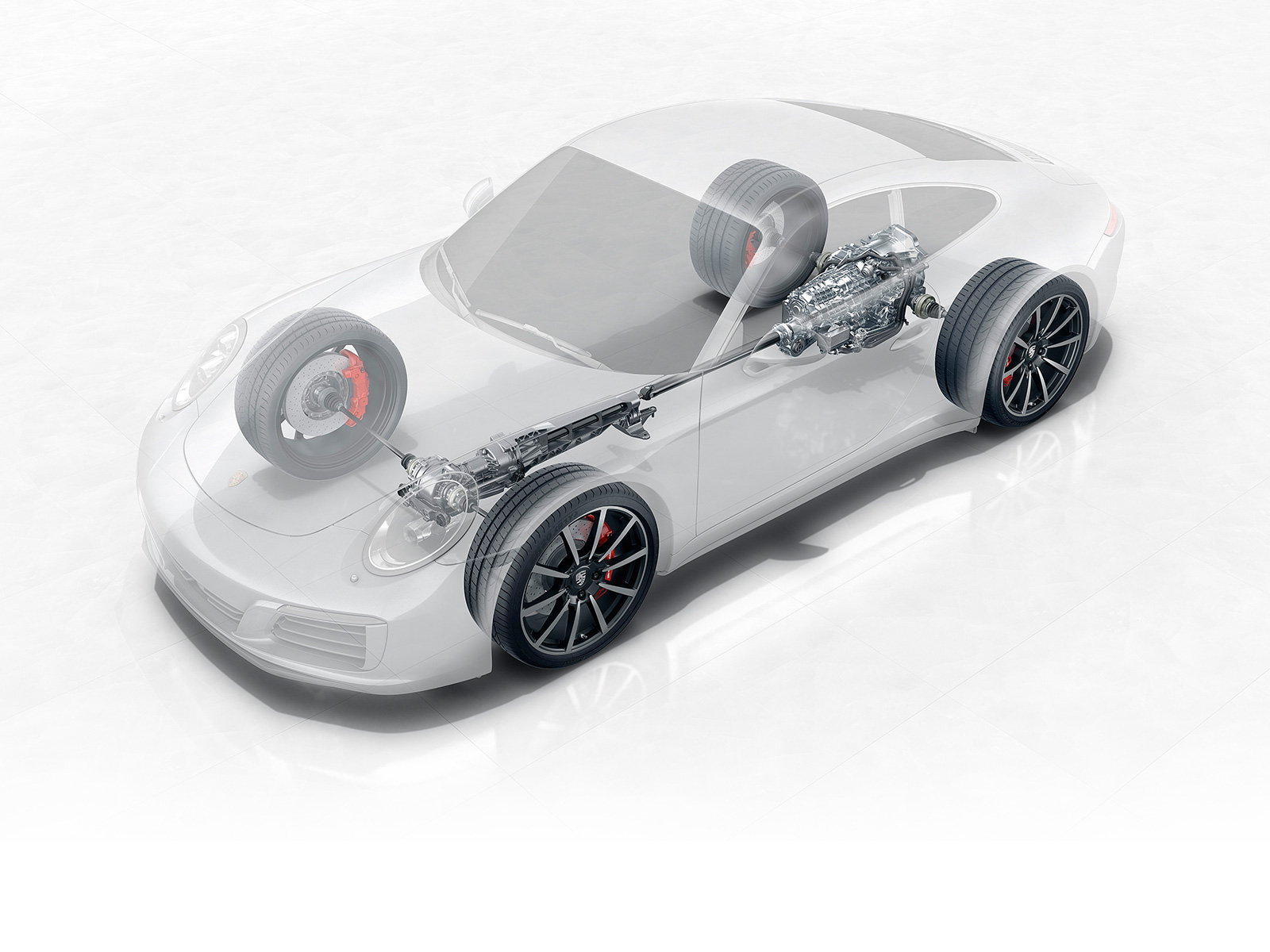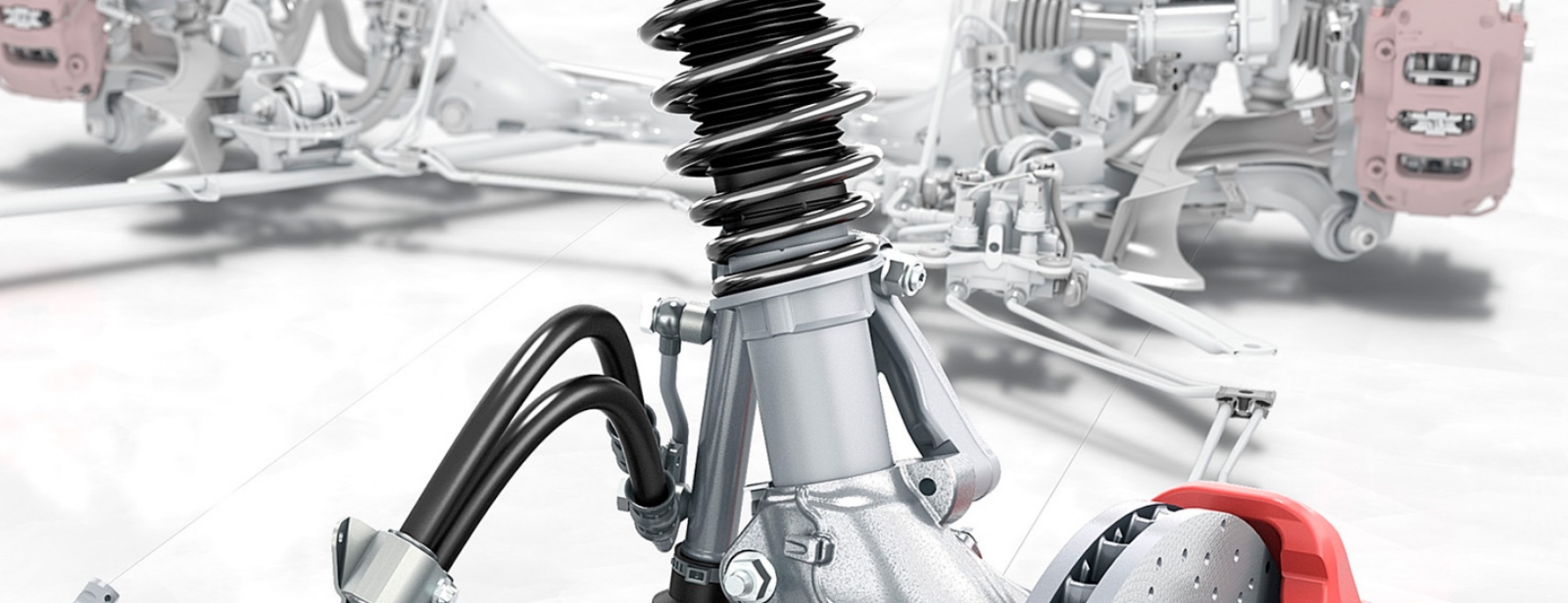.jpg)
2000 MY technology
For Porsche, the ultimate challenge is to exploit the limits of possibility. From the very beginning, Porsche has explored and even expanded those limits, whether on the racetrack or with innovative technology that enhances the driver’s experience on the road. Now, with the Cayenne® sport-utility vehicle, Porsche drivers are exploring and expanding the limits off-pavement, as well. Throughout its proud history, Porsche has been respected for the dynamic quality of its vehicles and for the engineering expertise and technological innovations that make those vehicles so safe, so secure and, yes, so exciting to drive. Following is a detailed look at some exciting Porsche technology for the 2004 model year:

VarioCam and VarioCam Plus are Porsche’s patented variable valve timing and valve lift technologies. Originally developed for the Porsche 911® Turbo, they are designed to optimize each vehicle’s dynamic capabilities while properly managing the fuel consumption and exhaust emissions of such high-performance engines. Similar technology can be found in every Porsche engine. VarioCam refers to cam timing adjustment that can be either a one-step system, as on the Porsche 911 Turbo, or a fully adjustable vane cell system, as on the 911 Carrera® models, the Porsche Boxster® and the Cayenne models. VarioCam Plus adds valve lift control and is used on the 911 GT2, Turbo and 911 Carrera models. VarioCam technology allows adjustment of the camshaft angle and is set to provide optimum performance for each Porsche engine. For example, in the Boxster, the camshaft angle can be adjusted by as much as 40 degrees compared to the crankshaft, reducing charge cycle losses, improving power, fuel consumption and keeping exhaust emissions to a minimum. In the Cayenne, an adjustment of up to 25 degrees assures a beefy torque curve for the sport utility’s V8 engine.
With VarioCam, intake camshaft timing is fully variable through a wing-cell adjuster fit directly on the camshaft drive sprocket. Oil pressure is used to turn the position of the inner wing-adjuster wheel versus the outer sprocket. Because the intake and exhaust camshafts are driven directly via a roller chain, this system makes the conventional three-stage chain drive redundant between the crankshaft and the camshaft. Porsche’s patented VarioCam responds quickly to any sudden need for power or, conversely, to a more reserved style of driving, say in city traffic. This is possible because of the way it makes precise adjustments to valve opening and closing times. When running under part load, the intake camshaft is set to an earlier opening point. The residual gas remaining in the combustion chamber builds up maximum output through the small overlap in the opening and closing times. Maximum torque is provided by extended valve overlap and the earlier conclusion of the intake period. VarioCam Plus not only adjusts camshaft position to provide continuously adjustable valve timing, but also varies valve lift and duration. This helps to flatten as well as smooth the torque curve while reducing emissions. The use of dual valve springs ensures reliable high-performance operation. Some have said that driving a Porsche equipped with VarioCam Plus technology is like having two engines in one vehicle: an engine that provides maximum horsepower and torque and another that provides quiet and efficient operation. However, Porsche technology combines these characteristics into each engine. Even under cold starting, VarioCam Plus improves the engine’s characteristics by reducing emissions through suitable adjustment while the engine warms up. While the engine is at idle, the small cams control valve lift and valve timing is optimized to keep any valve overlap to a minimum. The small valve lift serves to reduce friction, and thanks to the very short opening times it significantly increases the charge motion while reducing emissions from any previous combustion within the chambers. The system also reduces fuel consumption and emissions by as much as 10 percent. Under part load, valve lift shifts to a large overlap and the engine runs with internal recirculation of exhaust gases to minimize any throttle effect and to reduce fuel consumption. Under full load, maximum torque and horsepower are ensured by a highly efficient gas charge cycle with minimum losses as well as an uncompromising cam contour and suitable adjustment of valve opening and closing times.
The system is controlled by Motronic ME7.8 engine management software designed specifically for Porsche’s requirements. Engine speed, gas pedal position, engine oil and coolant temperature and even gear selection are monitored. The driver’s commands for horsepower and torque are compared with control maps. Within milliseconds, the computerized system responds and makes the proper adjustments.
.jpg)
In addition to the five-speed Tiptronic S transmission on the 911 and Boxster, Porsche offers a six-speed Tiptronic S in the Cayenne. This latest development is tailored specifically to the high torque and power level of the Cayenne Turbo, and thus is ideal for the Cayenne S model as well. This new six-speed Tiptronic S features modified shift units and a special torque converter. The system provides a wider range of individual gear increments and retains the driver’s option to shift gears manually by tipping the selector lever on the center console or simply by using switches on the steering wheel that can be activated by the driver’s thumb. The driver can press the upper portion of the thumb switch or tip the center console shift selector forward to advance the gears, or press the lower part of the thumb switch or tip the shift selector back to downshift.
One major advantage of the Tiptronic S is that it provides the driver with the option of intervening while the transmission is in automatic mode. The driver can move the thumb switch on the steering wheel and shift gears manually even though the gearshift selector lever in the center console remains in the automatic position. In such a case, the manual mode is activated for at least eight seconds, and this period is extended when the car is in “overrun” – for example, on a downhill grade, to capitalize on engine braking – or when the driver downshifts before the entrance to a curve and the car is under lateral acceleration as it negotiates the turn. When in such a situation, the letter “M” appears in the right-hand instrument dial and the specific gear currently engaged also is displayed. At the same time, the transmission retains its kick down function so the driver can downshift again as needed. The transmission can downshift by as many as three gears when the driver steps hard and quickly on the gas pedal.
In automatic mode, Tiptronic S adjusts to various shift control maps based on the driver’s style of driving and the route. The range of shift points extends from a particularly economic mode activated whenever the driver prefers a calmer and more reserved style of driving (with the gears shifting up at an earlier point and engine speeds being reduced accordingly) all the way to a very dynamic, active mode (with the gears remaining in mesh for as long as possible when accelerating, using the engine's free-revving driving characteristics). The crucial factor in all cases is the driver’s foot on the accelerator: Moving the gas pedal quickly and dynamically, accelerating frequently with full power, the gearshift points change accordingly, switching if necessary to the most dynamic variant and vice versa.
Over and above its ability to recognize the driver’s style, Porsche Tiptronic S also features:
A warm-up program that prevents the transmission from shifting up too soon, thus increasing the temperature of the catalytic converter as quickly as possible while allowing the engine to warm up smoothly and without any strain; • An active gearshift that immediately moves the shift points to the most sporting and dynamic program whenever the driver presses the gas pedal quickly and dynamically; • Suppression of upward gearshift in overrun when the driver’s foot suddenly lifts off the accelerator, for example, before entering a bend; • Downshifting to the next lower gear to optimize engine braking when the brakes are applied; • Increment upshift that delays shifting into a higher gear after an active downshift; • Retention of gears in a bend to prevent upshift; and • Hill recognition that retains lower gears as long as possible in uphill or downhill gradients.
To reduce the possibility of an improper shift when the Cayenne SUV is traversing rough terrain, the steering wheel switches are deactivated when the reduction gearbox is engaged. In this case, the driver can shift manually only by moving the shift lever on the center console. But the driver may not have to shift manually because Tiptronic uses gearshift control maps to ensure optimum power in rough terrain. Another Tiptronic S feature in the Cayenne is a hill-holder function that prevents the car from rolling backward when setting off in a forward gear, even on a steep grade.

With the introduction of the Carrera GT, Porsche launches the Porsche Ceramic Composite Clutch (PCCC). Ceramic composite clutches were developed for use in motorsports at the highest levels of international competition. However, in such applications and for specific use on the racetrack, they often have short lives. But applying lessons learned through the development of Porsche Ceramic Composite Brakes, Porsche has created a new clutch design and configuration that applies ceramic composite technology to the public roads with a two-plate dry clutch made from a composite of carbon fiber and silicon carbide. This ceramic composite clutch is compact and light, but also strong and has an exceptional service life. In the Porsche Ceramic Composite Clutch, the plates are only 6.65 inches (169 mm) in diameter, less than half the size of typical production car clutch plates, which can run as large as 15 inches (380 mm). Because it is extremely compact and lightweight, the PCCC contributes to the Carrera GT’s incredibly low center of gravity. The PCCC’s low mass also has a very positive effect on the dynamics of the Carrera GT’s 605-horsepower (SAE), 5.5-liter V10 engine and its six-speed, transversely mounted transmission.
.jpg)
Because of their exceptional performance in extreme conditions, ceramic composite brakes were developed for use in high-level motorsports competition. Porsche was the first automaker to apply them for road use, with Porsche Ceramic Composite Brakes (PCCB) included as standard equipment in the Porsche GT2 and Carrera GT and as an option in most other models. Ceramic composite brake discs provide a 50-percent weight savings compared to conventional metal discs. This reduces unsprung weight, enhances shock absorber response and vehicle handling, and also improves fuel efficiency and thus contributes to reduced emissions. Ceramic composite brake discs have an extremely hard surface that provides consistent frictional values throughout the deceleration process, even in braking from extremely high speeds and at high operating temperatures, such as those generated from repeated braking. But the system also provides benefits in low-speed situations. In the event of an emergency stop, PCCB technology does not require heavy pedal forces or outside technological boosting assistance to achieve maximum and immediate stopping force. With cross-drilled discs and pads that are resistant to water absorption, the ceramic composite brakes provide superior response in wet conditions as well as dry.
Because of their hard surface and immunity to salt corrosion, Porsche Ceramic Composite Brakes have an extremely long operating life.

Porsche Stability Management (PSM) helps keep a vehicle going in the direction the driver steers, whether on a dry paved road, a slippery road or even unpaved surface. PSM uses data from several sensor inputs to detect a loss of grip. The system reduces instability by applying brakes to individual wheels and, if necessary, by reducing engine power. PSM operates so quickly that most drivers will not notice its corrections. PSM is tuned to the driving style and skills of Porsche drivers. Drivers who want total control of their vehicle can disengage PSM with a switch located on the dashboard. However, for purposes of safety, PSM automatically engages under braking and then disengages when the driver lifts off the brake. Porsche also cautions drivers that while the system provides a dynamic handling aid, no system can overcome the laws of physics.

Drivers might think that the laws of physics do not apply to Porsche Traction Management (PTM), the newest generation in four-wheel drive technology that comes standard on every Cayenne. PTM significantly influences the Cayenne’s dynamic performance by coordinating the vehicle’s outstanding power and torque, its sporty and agile handling, and its excellent driving dynamics with superior performance off the beaten track. In normal conditions, PTM feeds 62 percent of the engine’s power to the rear wheels and 38 percent to the front wheels. This assures that the Cayenne has the same basic dynamic characteristics as the Porsche 911 and Boxster. However, through the use of a multiple-plate clutch, the Cayenne can vary the power split as needed, if necessary feeding 100 percent of the engine’s torque to the front or rear wheels. The map-controlled front-to-rear lock and the optional rear axle differential lock not only respond to lack of traction on the front or rear wheels, but incorporate sensors to measure such things as vehicle speed, lateral acceleration, steering wheel angle and operation of the gas pedal. PTM determines the optimum lock on both axles and distributes drive power as actually required to the front and rear wheels.
Thus PTM acts as an intelligently networked electronic system that helps to provide stability and safe lane change behavior both at high speeds and when driving on snow and ice at moderate speeds.
This innovation offers an impressive range of outstanding results, including:
• Excellent driving stability and traction in all situations, regardless of the frictional coefficient; • Better steering provided by the front-to-rear differential lock opening up to avoid any understeer effect; • A front-to-rear differential that ensures better control when driving to the limit; • Enhanced directional stability and better road grip by operating the front-to-rear lock as required; • Better traction by increasing locking action before the wheels start to spin.
Porsche Stability Management (PSM) remains consistently in touch with Porsche Traction Management (PTM), but intervenes only when the vehicle reaches its limits. Masterminding essential systems such as ABS (Anti-lock Braking System), ASR (Automatic Slip Regulation) and ABD (Automatic Brake Differential), PSM cuts in immediately under critical over- or understeer conditions and tells PTM to open up the locks to restabilize the vehicle by applying the brakes specifically on individual wheels.
The Cayenne successfully combines outstanding performance on the road with equally outstanding off-pavement abilities. Indeed, it is already a genuine master off the beaten track in its “basic” configuration, intelligent four-wheel drive enabling the Cayenne to easily cross light terrain without any adjustment of the traction systems. On rough terrain, the Porsche Traction System uses the reduced-ratio gearbox featured as standard equipment. With its reduction ratio of 2.7:1, the reduction gearbox is ideal for even the most extreme off-pavement maneuvers, easily handling steep gradients and, in particular, downhill passes. Activating the low-range mode by means of a toggle switch on the center console, the driver can automatically prepare several control systems for off-pavement driving conditions: PTM switches over to the reduced ratio for off-pavement requirements and changes to a special off-pavement control map activating the differential locks, PSM responds by setting ABS and ABD to a special traction mode for off-pavement motoring, and the air suspension featured as standard in the Cayenne Turbo automatically lifts the entire vehicle up to its off-pavement level. Porsche is the first carmaker to offer this combination of systems all controlled by one central off-pavement switch and thus significantly facilitating operation of these systems when driving under extreme conditions.

Porsche Active Suspension Management (PASM), a new variable damping system, is standard equipment on the Porsche Cayenne Turbo and is optional on the Cayenne S. PASM incorporates an air suspension system that provides extra ground clearance in rough terrain, automatically lowers the vehicle at highway speeds, and has a self-leveling feature that helps to provide a proper position regardless of passenger or cargo loads or the presence of a trailer. The air suspension incorporates six ride height levels, allowing a range of 4.56 inches. PASM further adjusts damper forces in response to road surface conditions and each driver’s style. For example, under the rapid and powerful application of the gas and/or brake pedal, as when driving aggressively on twisting roads, or when driving with cautious movements on particularly rough terrain, PASM steadies body sway and dive motions by monitoring body movement through five accelerometers. As soon as the motion of the Cayenne’s body exceeds programmed limits, PASM intervenes and works to stabilize the vehicle by acting on specific dampers. PASM also allows the Cayenne driver to select from Comfort, Normal or Sport modes. However, should a driver select, say, the Comfort mode but then operate the vehicle in a more sporting style, the system automatically switches to the Sport mode and makes the appropriate changes in damper settings. Porsche also cautions drivers that while the system provides a dynamic handling aid, no system can overcome the laws of physics.

Porsche Communication Management (PCM®) operates at the speed of light. Using Porsche’s MOST (Media-Oriented Systems Transport) technology, PCM uses light wave conductors to exchange multi-media data in every Porsche model in which it is installed. The big advantage of this technology is that it exchanges data without any loss of quality and at extremely high speeds. Among other features, this assures high-quality audio transmission for radio, CD changer and amplifier units. The customer decides on a specific level of PCM equipment when choosing a Porsche vehicle. For example, networking PCM with the instrument cluster via the CAN (Controller Area Network), the driver can view within the instrument cluster information such as radio station, music titles, and navigation pictograms.
Featuring a double audio tuner, CD player, dynamic route navigation, and trip computer, optional PCM provides a user-friendly design that includes a color screen and 12-digit keyboard. In the Cayenne, that screen is 6.5-inches across and provides the clarity of a 16:9 aspect ratio. The keyboard can be used for entering information such as radio station frequencies.
In addition, buttons beneath the display provide direct access to the individual menus such as trip computer (Trip button) or the navigation system (Navi button). Two buttons providing direct access to the Set (Set button) and Return (button with a bent arrow), thus avoiding the need to “jump around” from one sub-menu to another and waste a lot of time in the process. As well as interference-free radio reception, ensured by a modern double tuner consistently looking for the best frequency, the navigation module features the following outstanding highlights:
• Large choice of various navigation functions: Functions can also be presented on the map in the display, informing the driver of such facilities as restaurants, service stations or parking lots; • On-demand road junction zoom: This function automatically enlarges road junctions in the active guidance mode, providing helpful support above all at dangerous points where a road junction is unclear. • Map scroll: Benefiting from the wider range of map options, the user is able to shift the map display, scroll and position the map as required. This enhances navigation from the current location to the desired destination, checking out and memorizing a destination by means of a reticule display without having to enter the exact address. • Tour planning: The tour planning function allows the user to enter and memorize routes with as many as eight destinations in a row. When setting out, the system will automatically guide the driver to the individual destinations on the way, in precisely the order recorded in advance. Further processing options on such extended routes are also possible, such as adding information, removing destinations, changing the order of destinations on the way or skipping a certain point; • Music played by the navigation CD ROM drive: Apart from the usual navigation function provided by a CD-ROM, the new PCM system also allows memory-based navigation. In this case, after the route is calculated, the driver can remove the navigation CD and insert an audio CD into the CD-ROM drive. Should it be necessary to reinsert the navigation CD, for example to calculate an all-new route, the system will automatically inform the driver by generating an optical and an acoustic signal.

POSIP (POrsche Side Impact Protection) is standard on all Porsches and provides the driver and front passenger with a broader scope of protection than conventional side airbags. A special feature of POSIP is that this airbag system is able to ensure exemplary protection, even in an open convertible.
Housed in the door panel of Porsche sports cars, the airbag modules differ from conventional units through their large volume and airbag geometry. In a collision from the side, this ensures not only the usual protection of the torso, but also helps to protects the driver’s and front passenger’s head from hitting an obstacle at the side, regardless of the fore-and-aft position of the seats. Because of the size of its interior, the Porsche Cayenne sport utility vehicle gets a special airbag system that includes front, side and head curtain airbags. For the Cayenne, the side airbags have been placed in the backrests of the front seats. While providing protection for the driver and front-seat passenger’s heads, this separate airbag also helps to protects passengers sitting in the rear seat in the event of a side impact. This system is designed to provide protection even when a narrow obstacle, such as a pole or a tree, strikes the vehicle.
.jpg)
2000 MY technology

Forty Years of the Porsche 911

Porsche Press kit

Porsche Literature

Our Porsche Cars